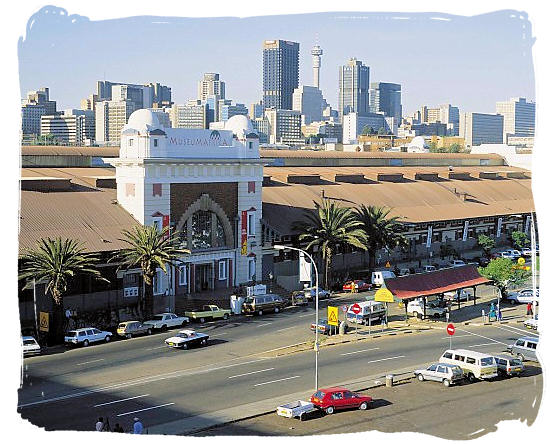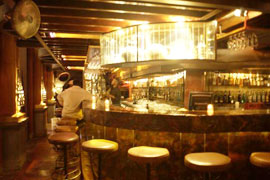 |
| Above: Museum Africa,Newtown,Johannesburg,South Africa. This picture was taken from a top view just after it was built in 1994. |
 |
| Above: Museum Africa,Newtown,Johannesburg,South Africa. This picture was taken recently from the Marifitzgerald Square in Newtown. |
Founded in Newtown in 1994, Museum Africa is Johannesburg's major historical museum. Evocative multimedia displays and walk-through reconstructions of various historic periods take visitors on a journey from the city's golden era to the present day.
There are special exhibits on domestic labour, shack life and township jazz, as well as the role of two great 20th-century heroes, Mahatma Gandhi, who lived and worked in the city, and Nelson Mandela, who was jailed in The Fort after the historic 1956 Treason Trial.But Johannesburg's story goes back much further, and the museum also focuses on early man, Stone and Iron Age communities, as well as the first white settlers in the area. From the very earliest of times there is the unique collection of rock paintings and engravings.
 |
Above: Some of the Displays found inside Musem Africa,Newtown,Johannesburg,
South Africa.
 Above: Workers Museum,Newtwon,Johannesburg,South Africa.
Just down the road from Museum Africa,opposite SophiaTown Bar Lounge, there is another historical Museum known as the Workers' Museum.
Designed by Henry Paine and Barry Gould, Workers’ Museum is located in Newtown, Johannesburg, South Africa. Industrial heritage has enormous cultural significance for a city like Johannesburg where the markers of mining and industrial heritage are often regarded as inconvenient and ugly. The Workers’ Museum has value, not only by adaptively re-using an historical / industrial structure, but by commemorating its past use through its new functioning as a museum reflecting the lives of oppressed working people.
The compound typology was introduced by the diamond mines in the 1870’s as a means to control their workers.The new building has been constructed from steel glass concrete and brick in such a way as to avoid any competition with the existing building but to make a clear entrance marker. By using old photographs, the architects were able to restore a few of the rooms to reflect what they would have looked like historically. Adaption is facilitated by the insertion of mezzanine levels and staircases serving as exhibition areas for museum artefacts. ‘Old’ and ‘New’ are legibly distinct and different.

Above: Outside the Workers' Museum,Newtown,Johannesburg,South Africa.
Design by Henry Paine and Barry Gould
|
When to go: The museum is opened during the day every day of the week. Not too sure of the exact times but I would think it would generally be opened between 09h00 and 17h00.
How to get there: The simplest way to get there would be to come by car. Or you could try looking for Sci-Bono Centre on your GPS as you’re going to park in that parking lot. To get there from north Jozi, take the Jan Smuts off-ramp from the M1 South and follow this road through Braamfontein. Go over the Nelson Mandela Bridge and take your first right turn into Carr Street. Then take a left into Miriam Makeba Street. Drive till you see Sci-Bono in front of your and Turbine Hall on your left. Turn right into the parking lot (which was once cooling towers – a small cooling tower still actually stands in the parking lot although you probably won’t recognise it seeing that it is so small.)
Cost: The museum is free but there is a donation box and if I remember, the info kiosk does have some things for sale. Support them.
Anything Else: When you go to check out the museum, I suggest getting to the museum early then doing a walking tour of Newtown.








